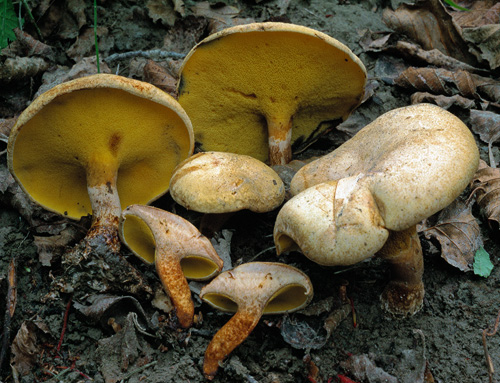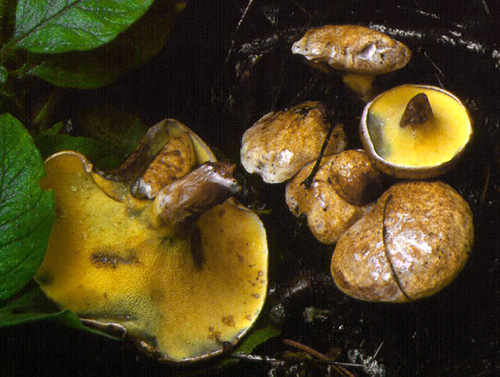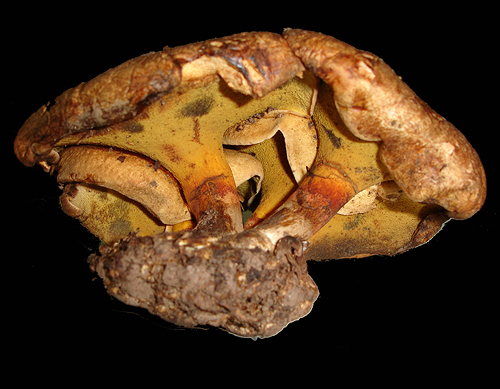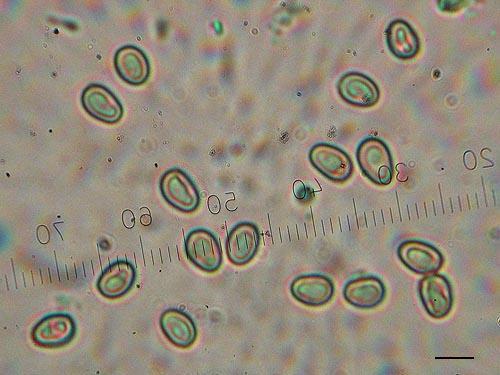Gyrodon Opat.
The only European member of this genus is usually easily recognized due to the combination of its overall appearance, very short tubes and small broadly ellipsoid spores, as well as for its mycorrhizal association with alders.
Gyrodon lividus (Bull. : Fr.) P. Karst.
Description
Fruitbodies often caespitose. Cap up to 7 cm, at first hemispherical then expanding to convex or flat-convex, whitish, cream, pale ochraceous, pale buff to buff, pale yellowish brown, pale cinnamon, sometimes almost grey, often with reddish tints, sometimes rusty spotted, viscid especially in wet weather, otherwise dry, smooth or felty, sometimes scaly. Stipe often eccentrically attached, cylindrical or spindle-shaped and usually tapering towards the base, mostly cream or yellow, often in places with rusty to brownish tinges. Flesh cream in the cap, yellowish to orange-yellow in the stipe, usually brownish in the stipe base, blueing in the cap and unchanging in the stipe when exposed to air. Tubes very short, not exceeding 5 mm, yellow to bright yellow when young, later with some olivaceous tint, decurrent (going down the stipe), blueing when exposed to air. Pores yellow to bright yellow when young, later with some olivaceous tint, blueing when bruised. Smell not distinctive. Taste not distinctive. Spores 5–8 × 3.5–4.5 μm.
Habitat. In a variety of habitats, where its mycorrhizal trees, alders (Alnus), are present.
Distribution. Widespread in Europe, but rare in a number of countries.
Photographs

Rich collection of fruitbodies of Gyrodon lividus. Note the overall shape, the very short tubes, the colours and the context of the cut fruitbody. (photo Y. Sytilidis)

Fruitbodies of Gyrodon lividus in different stages of development. (photo G. Konstantinidis)

Fruitbodies of Gyrodon lividus may often appear in groups. The darkening of the pores and the decurrent tubes are also notable. (photo P. Mavros)

Detail of the hymenophore of Gyrodon lividus. Note the peculiar shape of the decurrent pores. (photo A. Akulov)

Basidiospores of Gyrodon lividus. Scale bar = 5 μm. (photo B. Assyov)
Important literature
Alessio, C.L. 1985. Boletus Dill. ex L. (sensu lato). – In: Fungi Europaei. Vol. 2. Pp. 1–705. Libreria editrice Biella Giovanna, Saronno.
Breitenbach J. & Kränzlin F. 1991. Pilze der Schweiz. Bd. 3(1). Röhrlinge und Blätterpilze. Verlag Mykologia, Luzern.
Estadès, A. & Lannoy, G. 2004. Les bolets européens. – Bulletin Mycologique et Botanique Dauphiné-Savoie 44(3): 3–79.
Galli, R. 1998. I Boleti. Atlante pratico-monographico per la determinazione dei boleti. Edinatura, Milano.
Knudsen, H. & Vesterholt, J. [eds.]. 2008. Funga Nordica. Nordsvamp, Kopenhagen.
Lannoy, G. & Estadès, A. 2001. Les Bolets. Flore mycologique d’Europe. Documents Mycologiques Mémoire Hors série no. 6. Pp. 1–163. Association d’Écologie et de Mycologie, Lille.
Muñoz, J.A. 2005. Boletus s. l. – In: Fungi Europaei. Vol. 1. Pp. 1–951. Edizioni Candusso, Alassio.
Pilát, A. & Dermek, A. 1974. Hríbovité huby. Československé hríbovité a sliziakovité huby (Boletaceae – Gomphidiaceae). Veda, Bratislava.
Šutara, J., Mikšík, M. & Janda, V. 2009. Hřibovité houby. Čeled’ Boletaceae a rody Gyrodon, Gyroporus, Boletinus a Suillus. Academia, Praha.
Watling, R. 1970. Boletaceae, Gomphidiaceae, Paxillaceae. – In: Henderson, D.M., Orton, P.D. & Watling, R. [eds]. British fungus flora. Agarics and Boleti. Vol. 1. Royal Botanic Garden, Edinburgh.
Watling, R. & Hills, A.E. 2005. Boletes and their allies (revised and enlarged edition). – In: Henderson, D.M., Orton, P.D. & Watling, R. [eds]. British Fungus Flora. Agarics and boleti. Vol. 1. Royal